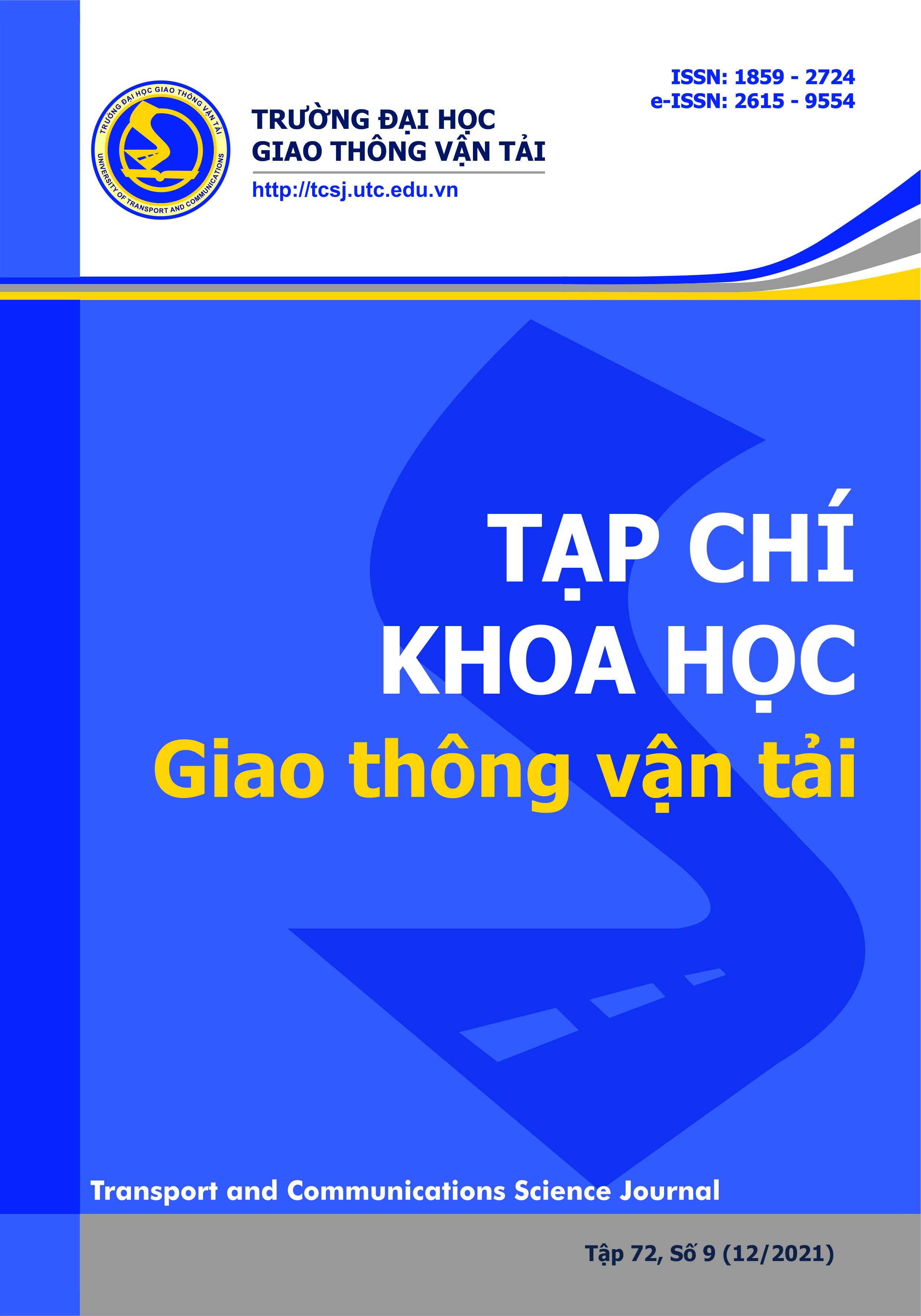Xác định độ thấm có hiệu của mô hình bê tông bị nứt bằng phương pháp PTHH
Email:
tbthao.tran@utc.edu.vn
Từ khóa:
bê tông nứt, cốt liệu thô, độ thấm có hiệu
Tóm tắt
Độ bền của kết cấu bê tông có chứa vết nứt phụ thuộc rất lớn vào đặc tính thấm nước của nó. Sự hiểu biết về hiện tượng truyền dẫn cho phép xác định tuổi thọ và tối ưu hoá việc thiết kế thành phần vật liệu. Vì vậy mục tiêu chính bài báo là nghiên cứu ảnh hưởng của quy luật phân bố vết nứt đến độ thấm có hiệu của mô hình mô phỏng số khối bê tông. Để đạt được mục tiêu này, trước tiên mẫu bê tông hai chiều với các hạt cốt liệu thô được khởi tạo. Tiếp đến hệ thống các vết nứt được bố trí ngẫu nhiên với sự thay đổi về mật độ. Cuối cùng các đặc tính thuỷ lực của mô hình đề xuất được xác định bởi phương pháp phần tử hữu hạn. Hơn nữa, những kết quả số thu được được dùng để chứng minh, phân tích mức độ ảnh hưởng của mật độ vết nứt và quy luật phân bố của chúng đến tính thấm có hiệu của mô hình bê tông bị nứtTài liệu tham khảo
[1]. H.W. Reinhardt, Penetration and permeability of concrete: barriers to organic and contaminating liquids, RILEM Report 16, E&FN Spon, London, (1997).
[2]. C. Hall, W.D. Hoff, Water Transport in Brick, Stone and Concrete, Spon Press, London, (2012).
[3]. L. Basheer, J. Kropp, D.J. Cleland. Assessment of the durability of concrete from its permeation properties: a review. Constr. Build. Mater., 15 (2001) 93–103. https://doi.org/10.1016/S0950-0618(00)00058-1
[4]. M. N. Vu, S. T. Nguyen, M. H. Vu, Modeling of fluid flow through fractured porous media by a single boundary integral equation, Eng. Anal. Boundary Elem., 59 (2015) 166-171. https://doi.org/10.1016/j.enganabound.2015.06.003
[5]. I. I. Bogdanov, V. V. Mourzenko, J. F. Thovert, Effective permeability of fractured porous media in steady state flow, Water Resour. Res., 39 (2003) 13/1-13/16. https://doi.org/10.1029/2001WR000756
[6]. M. Choinska, H. Al-Khazraji, N. Benkemoun, A. Khelidj, Influence of tensile cracking and of aggregate size on concrete permeability, MATEC Web of Conferences, 163 (2018) 02001. https://doi.org/10.1051/matecconf/201816302001
[7]. Y. Cao, J. E. Kilough, An Improved Boundary Element Method for Modeling Fluid Flow through Fractured Porous Medium, SPE Reservoir Simulation Conference, Montgomery, Texas, USA, February 2017, ISBN: 978-1-61399-483-2. https://doi.org/10.2118/182658-MS
[8]. T. Chen, Equivalent Permeability Distribution for Fractured Porous Rocks: Correlating Fracture Aperture and Length, Geofluids, 2020 (2020) 8834666. https://doi.org/10.1155/2020/8834666
[9]. A. Pouya, M. N. Vu, Numerical Modelling of Steady-State Flow in 2D Cracked Anisotropic Porous Media by Singular Integral Equations Method, Transp. Porous Med., 93 (2012) 475-493. 10.1007/s11242-012-9968-1
[10]. A. Lachihab, K. Sab, Aggregate composites: a contact based modeling, Comput. Mater., 33 (2005) 467-490. https://doi.org/10.1016/j.commatsci.2004.10.003
[11]. A. Lachihab, K. Sab, Does a representative volume element exist for fatigue life prediction? The case of aggregate composites, Int. J. Numer. Anal. Meth. Geomech., 32 (2008) 1005-1021. https://doi.org/10.1002/nag.655
[2]. C. Hall, W.D. Hoff, Water Transport in Brick, Stone and Concrete, Spon Press, London, (2012).
[3]. L. Basheer, J. Kropp, D.J. Cleland. Assessment of the durability of concrete from its permeation properties: a review. Constr. Build. Mater., 15 (2001) 93–103. https://doi.org/10.1016/S0950-0618(00)00058-1
[4]. M. N. Vu, S. T. Nguyen, M. H. Vu, Modeling of fluid flow through fractured porous media by a single boundary integral equation, Eng. Anal. Boundary Elem., 59 (2015) 166-171. https://doi.org/10.1016/j.enganabound.2015.06.003
[5]. I. I. Bogdanov, V. V. Mourzenko, J. F. Thovert, Effective permeability of fractured porous media in steady state flow, Water Resour. Res., 39 (2003) 13/1-13/16. https://doi.org/10.1029/2001WR000756
[6]. M. Choinska, H. Al-Khazraji, N. Benkemoun, A. Khelidj, Influence of tensile cracking and of aggregate size on concrete permeability, MATEC Web of Conferences, 163 (2018) 02001. https://doi.org/10.1051/matecconf/201816302001
[7]. Y. Cao, J. E. Kilough, An Improved Boundary Element Method for Modeling Fluid Flow through Fractured Porous Medium, SPE Reservoir Simulation Conference, Montgomery, Texas, USA, February 2017, ISBN: 978-1-61399-483-2. https://doi.org/10.2118/182658-MS
[8]. T. Chen, Equivalent Permeability Distribution for Fractured Porous Rocks: Correlating Fracture Aperture and Length, Geofluids, 2020 (2020) 8834666. https://doi.org/10.1155/2020/8834666
[9]. A. Pouya, M. N. Vu, Numerical Modelling of Steady-State Flow in 2D Cracked Anisotropic Porous Media by Singular Integral Equations Method, Transp. Porous Med., 93 (2012) 475-493. 10.1007/s11242-012-9968-1
[10]. A. Lachihab, K. Sab, Aggregate composites: a contact based modeling, Comput. Mater., 33 (2005) 467-490. https://doi.org/10.1016/j.commatsci.2004.10.003
[11]. A. Lachihab, K. Sab, Does a representative volume element exist for fatigue life prediction? The case of aggregate composites, Int. J. Numer. Anal. Meth. Geomech., 32 (2008) 1005-1021. https://doi.org/10.1002/nag.655
Tải xuống
Chưa có dữ liệu thống kê

Nhận bài
26/09/2021
Nhận bài sửa
23/10/2021
Chấp nhận đăng
09/11/2021
Xuất bản
15/12/2021
Chuyên mục
Công trình khoa học
Kiểu trích dẫn
Trần Thị Bích, T. (1200). Xác định độ thấm có hiệu của mô hình bê tông bị nứt bằng phương pháp PTHH. Tạp Chí Khoa Học Giao Thông Vận Tải, 72(9), 1047-1056. https://doi.org/10.47869/tcsj.72.9.4
Số lần xem tóm tắt
310
Số lần xem bài báo
572









